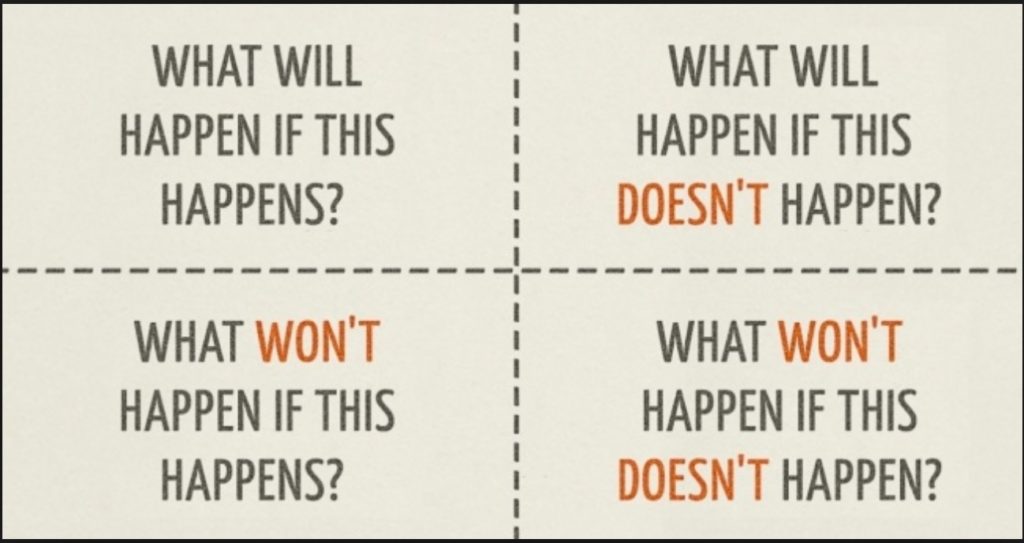 It is important not to confuse the notion of management with metrics.
It is important not to confuse the notion of management with metrics.
Metrics are important – when they add to our understanding.
However, frequently they substitute for understanding.
Creating our own RELEVANT metrics is time consuming, so there is a natural human tendency to seek short-cuts. For example when benchmarking first came to our attention it was through a thorough examination of the company’s own processes and comparison with those of its chosen exemplar. It took a lot of time, but was very successful. Others wanted the success but were not prepared to put in the time and effort understanding either their own processes or those of the intended benchmark. So they skipped the understanding and analysis stage and went straight to collecting metrics. A lot of time was wasted and bad judgement calls made in the 1990s and 2000s because of this. Using figures from other times, places and cultures without understanding is as foolish as it sounds, but is still being done.
The ‘life’ of assets is an important factor in many decisions, from costing, to planning, to intervention. But few ‘lives’ are calculated based on the type of asset involved and conditions of its use. Some years ago, a Transport Company assumed that the life of its buses was 12 years. No-one actually knew where the figure came from but they swore by it. When challenged, it turned out that the figure had come from a statement – made some 15 years earlier – by the Chief Engineer at the time who had said: “We don’t know how long a bus should last but it certainly shouldn’t be more than 12 years.” This was a statement based on his best professional judgement at the time. But 15 years had passed. When a proper analysis was conducted the figure turned out to be 16+ years. So the outcome of accepting, uncritically, the earlier metric, had caused early disposal and a 25% loss in bus value.
Question: What has been your experience with metrics?
 With the world changing as fast as it is today, I suggest we need to look again at a number of notions that may have served us well in the past but may now be outdated or corrupted. In any case, they warrant a critical ‘second look’. And where better to start than with the well know prescription
With the world changing as fast as it is today, I suggest we need to look again at a number of notions that may have served us well in the past but may now be outdated or corrupted. In any case, they warrant a critical ‘second look’. And where better to start than with the well know prescription
“If you can’t measure it, you can’t manage it”
Where did this come from?
It is usually ascribed to Edward Deming (or, sometimes, Peter Drucker). Deming was an American statistician who rose to fame by helping Japanese manufacturing industry improve the quality and reliability of its product through concentrating on measures that enabled them to reduce variability.
But Deming didn’t actually subscribe to this at all!
Deming is often misquoted as saying, “You can’t manage what you can’t measure” but Deming realised that many important things that must be managed can’t be measured. He asked “Spend $20,000 training 10 people in a special skill. What’s the benefit?”, and answered “You’ll never know! You’ll never be able to measure it. Why did you do it? Because you believed it would pay off!”
In “Out of the Crisis” (p.121), Deming cites Lloyd S. Nelson, director of statistical methods for the Nashua corporation, “The most important figures that one needs for management are unknown or unknowable, but successful management must nevertheless take account of them.”
So what are the downsides of adhering to this prescription?
Gut feel, intuition, imagination all play a role in management, but today we tend to denigrate these elements and consider them less important than metrics. (As an aside, every business man is urged to do consumer surveys to measure the likely demand for new products and to then base his decision on the metrics. As is now well recognised, if Steve Jobs had thought that way we would not now have the iPhone, the iPad, and the iPod; products that, at the time, were beyond customers’ perceptions.)
There is more to management than simply measurement.
Question: What are the Upsides, and what the Downsides of uncritical acceptance of this management prescription?
 Another way to look at critical infrastructure.
Another way to look at critical infrastructure.
Linda Newton, at Carlton Univeristy in Canada teaches part of a program called ‘Infrastructure Protection & International Security’. It’s unique in that it combines students with a policy/international studies background with students with an engineering/architecture background. Each group takes courses from the other area along with several core courses.. Linda’s focus is on the definition used by both ISO 55000 and the European Commission but starts by positioning Critical Infrastructure from a historical perspective.
How did it evolve?
Is what was critical in the past still critical today and will it remain critical? This really gets students thinking about Critical Infrastructure. She uses photographs to illustrate the evolution of Critical infrastructure in the first lecture of the course & then asks ‘what’s the link between the following: e.g. Tower of London, London Docklands (now parks), Berlin Wall, Minuteman missile silos, etc.?’ (Answer: They were all critical at one point in history.)
The focus is on what makes an asset critical
This is both from the definition and then within its category, not on the vulnerability of assets from a security perspective but from an AM perspective. The role of an Asset Manager is to ensure infrastructure is managed as best as possible so that those who make emergency preparedness/business continuity planning decisions, whether the Critical Infrastructure is public or private, do so knowing the state of their respective critical assets. It’s the job of the AM to ensure there is redundancy and resiliency in critical assets, and advise accordingly, not because of an ‘evil intent’ but because it’s sound AM. It’s about information and making sure we have what we need at all phases to make informed decisions.
How do you look at – and deal with – critical infrastructure?
 When the Australian Government created a new body to scrutinise infrastructure asset sales for security risk, it occurred to me that we have made infrastructure vulnerable by making it large and interconnected. This is true of both physical and financial infrastructure (e.g. the banking system).
When the Australian Government created a new body to scrutinise infrastructure asset sales for security risk, it occurred to me that we have made infrastructure vulnerable by making it large and interconnected. This is true of both physical and financial infrastructure (e.g. the banking system).
In the past this was a means to greater efficiency and we were prepared to take the risks involved. Today, with technological developments, however, we can decrease the criticality of critical infrastructure by disaggregating, decentralising, and changing the ownership structure. This is particularly so for banking. But take electricity as an example. A series of interconnected, community-owned, local solar grids would be less susceptible to power failures as well as to actors of ‘evil intent’.
The blockage is the change in ownership structure. Not unnaturally, incumbents stand to lose. Large companies and governments in electricity supply are vulnerable to both criticality and financial risks. They have been putting a lot of thought into the changes that can be made so that we should not assume that they will resist change – although it is probably in their interest to slow it down. We all fight to preserve our own, it’s only natural.
So, if we want to see change in the community interest, it is in that interest to find ways to help current owners make the transition – profitably and with minimal delay.
What is being done, or could be done? What could we support? Ideas?

Hamurabai today?
Hammurabi reigned over Babylon from 1795-1750 BC. The code of law that he set down (on an 8 foot stone pillar) is considered the predecessor of Jewish and Islamic legal systems alike. Here are rules that applied for a house builder
- If a builder build a house for some one, and does not construct it properly, and the house which he built fall in and kill its owner, then that builder shall be put to death.
- If it kill the son of the owner the son of that builder shall be put to death.
- If it kill a slave of the owner, then he shall pay slave for slave to the owner of the house.
- If it ruin goods, he shall make compensation for all that has been ruined, and inasmuch as he did not construct properly this house which he built and it fell, he shall re-erect the house from his own means.
- If a builder build a house for some one, even though he has not yet completed it; if then the walls seem toppling, the builder must make the walls solid from his own means.
The Hamurabi code was brutal – but no doubt extremely effective. Poor workmanship in roads and other major infrastructure is not mentioned – infrastructure was somewhat limited back in Babylonian times.
Question for today: If you were to bring the code up to date for infrastructure, what might you include? And would you limit your penalties to workmanship alone, or would you include poor decision-making? Have fun!

That’s interesting! I wonder why?
Over the last few posts, I have been looking at assumptions. Questioning assumptions is a way of more fully engaging with the ideas presented, of getting involved in the dialogue.
However asking ‘Why?’ should not be an excuse to let loose our inner 4-year old. We owe it to our own understanding and that of others to say ‘why we are asking why’.
Is it because we genuinely do not understand and want to know more (a neutral stance)? Then, let’s be honest and say so. Admitting we need to know more is a sign of intelligent recognition of our own (current) limits.
Often it is because we believe the assumption to be at fault and we are seeking to trip up the speaker with our question. This is not such a neutral stance. It is also probably responsible for our reaction when our own assumptions are challenged, to vigorously defend them and to suppose the questioner must be at fault – and probably just a bit stupid! So now we have an antagonistic situation where neither party learns anything.
There is a way out of this negative situation. Whether it is your assumptions that are being questioned, or the assumptions of others are arousing doubt in you, the most productive reaction is to say “That’s interesting! I wonder why?” Why is my assumption being questioned? Why am I having a gut reaction to the assumption of another? In both cases, by all means think through possible answers, but be wary of too quickly coming to a conclusion. Ask! But in a spirit of genuine, interested, curiosity. If you preface your question with “That’s interesting!” (and mean it!) you will be surprised by the genuine conversation that can follow.
Thoughts?

What will happen next?
In the last post I suggested that we shouldn’t be shy about questioning assumptions. But what? ALL assumptions?
Assumptions serve a purpose, otherwise they wouldn’t have lasted so long. They enable us to take shortcuts. Suppose I assume it is going to be sunny and don’t take a coat when I walk to the neighbourhood shops and get caught in a downpour. What are the consequences? I get wet and I am uncomfortable. But it doesn’t last long, and I am the only one affected. True, it would have taken but a moment or so to check my iPhone, so I probably also feel an idiot. But that’s it. Cost is small, temporary, and impact is limited.
Now consider an infrastructure decision where:
- the costs are large,
- the consequences last a long time, and
- they impact many people.
So when the consequences are low, by all means save yourself the effort if you wish, but if they are high – and particularly when the consequences are to be borne by others – we owe it to them to check, to question, to verify.
The DESCARTES SQUARE is a useful tool to ensure that ALL consequences are considered:


Desert island
An engineer, a physicist and an economist are shipwrecked on a desert island. All they have is a tin of baked beans but how are they to open it? The engineer considers hitting it with a rock, the physicist suggests heating it over a fire. The economist, however, smiles and says: ‘Let us assume we have a tin opener’.
I am an economist, so assumptions come very easily to me, I know how useful they can be. However, I have also learnt to be wary of their uncritical use – and there is an awful lot of uncritical use around today. Why is this? To understand, we need to ask
What are assumptions and where do they come from?
I once assigned a problem to an engineer working for me. I told him that he could solve the problem any way he liked, just so long as he documented all the assumptions that he made. After a couple of weeks, he supplied his solution. “And where are your assumptions?” I asked. “Oh, I didn’t make any!” he replied.
I pointed to a number of the assumptions in his solution and said “What about this – and this?” “They are not assumptions” he repied indignantly, “they are the results of my years of experience!”
And that, in a nutshell, is why assumptions are so valuable – and, at the same time, so dangerous. Our years of experience enables us to take shortcuts to get the work done but only when doing things the way we always have. When change comes, doing – and thinking – ‘the way we always have’, stops being a shortcut, and becomes a fast track to disaster.
When change comes, we need to rethink our assumptions but years of conditioning makes this very hard, if not impossible.
To succeed in a changing world, we must learn to question assumptions.
Question: But how?

Collection of differences
When I was an Economics Honours student, our small class was visited by John Stone, who later became Secretary to the Treasury. He was on a Treasury recruitment mission. Early in his talk he referred to the Karmel Report on Education and how poor it was. Prof Karmel had been our Head of Department so I felt honour bound to take up the challenge: “Professor Karmel is a highly regarded economist, so how come this report is as bad as you say it is?”
Consider the Committee!
He did not go on the defensive, instead he gave us a pen picture of each member of the Committee that had produced the report. I remember one fellow being described as ‘a businessman who believes that there should be ten people lined up outside his factory gate for every vacancy he has available’.
As a student I had naively looked at reports as objective statements of fact, carefully argued. But after that visit, I saw that all reports are in fact a compromise of the various views of the members comprising the Committee. Before the visit I had thought that an ‘independent’ report meant it was independent of the government, but then who chooses the committee?
Unless we know who is on the Committee and the way they see the world, it is hard to appreciate the conclusions reached. Often the titular head of the committee, the one whose name is associated with the report – as Prof Karmel was in this case – is chosen for his reputation, but the committee is chosen for their views (and there are more of them!)

Filling up from water trucks. Courtesy: Planet Thoughts.
In Australia, our regional cities are struggling for lack of activity and our capital cities are at risk of becoming disfunctional, particularly on the fringes, because of too much activity! The activity I speak of is infrastructure investment.
Why are we so hell-bent on developing mega cities? Big does not mean strong. It does not mean resilient. There is a lot of evidence world wide. Consider:
A horror story – current and continuing
The problems of Mexico City. See Mexico City, parched and sinking, faces a water crisis, an interactive report by the New York Times.
Now ask yourself, what lessons could we learn from this – and how many of the problems being faced there are exacerbated, even created, by high urban densities. And if water is not enough of a problem for you, consider transport, social and environmental issues. How many of our problems do we bring on ourselves? And how could we better manage by re-directing our growth efforts?

Recent Comments